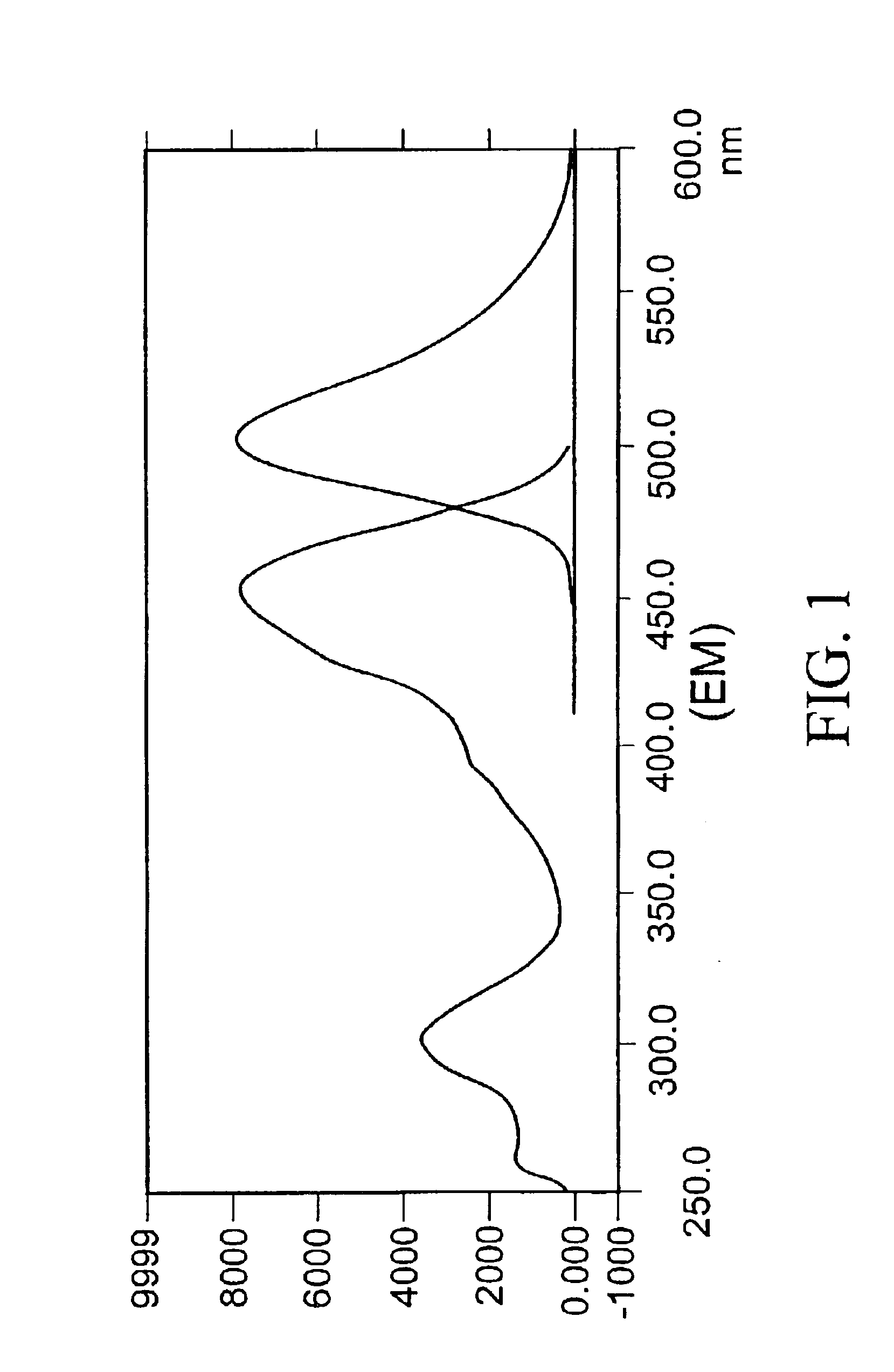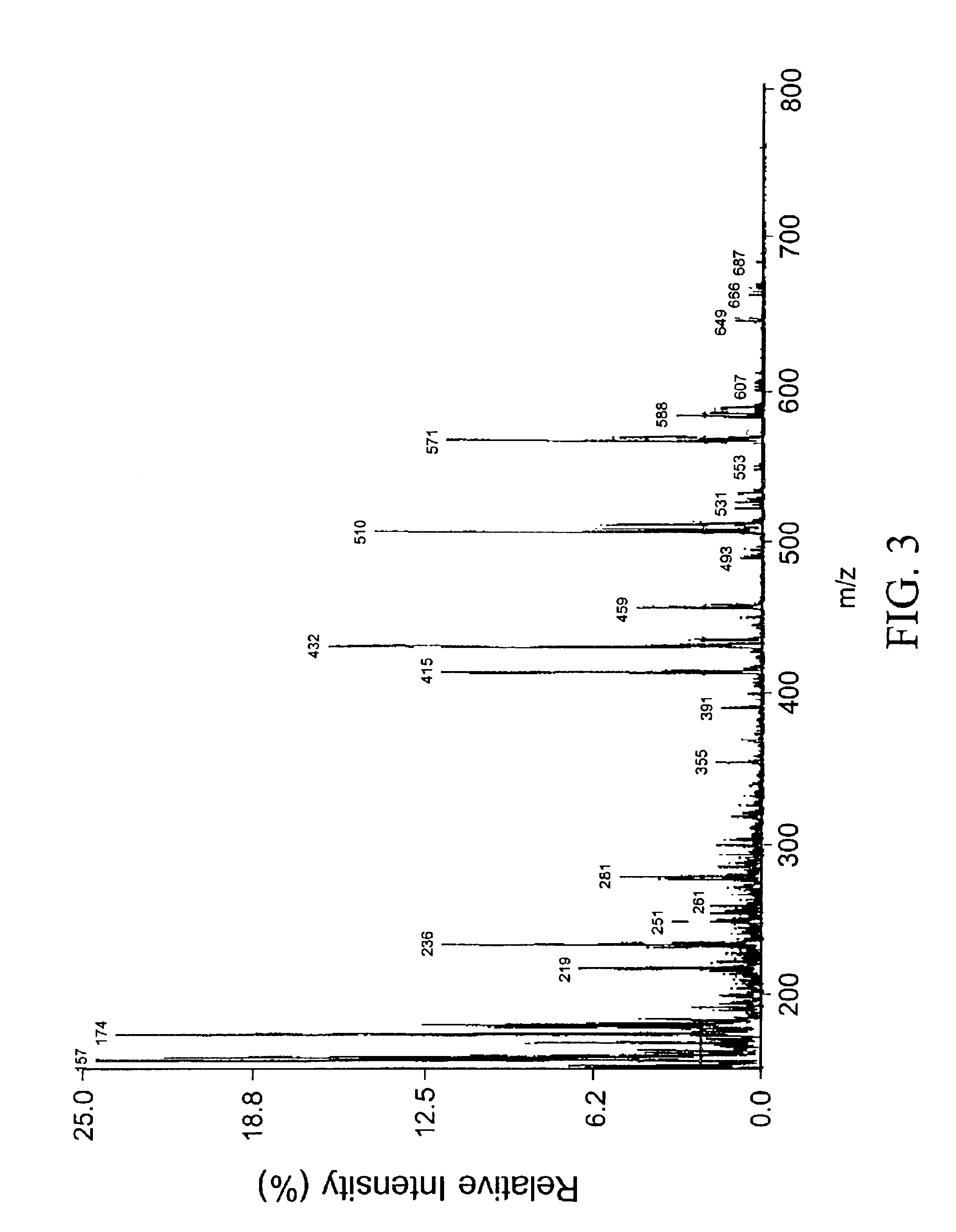Fluorogenic substrates
a technology of fluorogenic peroxidase and substrates, applied in the field of fluorescent substrates, can solve the problems of laborious use requirements, low detection efficiency, and low use efficiency of fluorogenic peroxidase substrates, and achieve high conversion rate to products, high sensitivity, and high stability to non-enzymatic hydrolysis.
- Summary
- Abstract
- Description
- Claims
- Application Information
AI Technical Summary
Benefits of technology
Problems solved by technology
Method used
Image
Examples
example 1
Preparation of Chloro-Phosphatepyrene-Disulfonic Acid Pentammonium Salt, (CPPD)
[0064]1 g (1.9 mMole) 1-hydroxypyrene-3,6,8-trisulfonic acid trisodium salt (HPTS) and 1.59 g (6 mMole) 18-Crown-6 were suspended in 20 ml dry pyridine. After stirring at room temperature for 0.5 hour, a clear yellow solution was obtained. While cooled in an ice-water bath and with stirring, 800 μl POCl3 (8.8 mMole) was added to the HPTS solution dropwise. The solution was left stirring in ice-water bath for 2 hours. After 2 hours, the reaction was checked by TLC and was found to be complete. The reaction mixture was poured over 5 ml ice and solvents were removed under reduced pressure. The residue was then dissolved in 30 ml H2O. While cooling in an ice-water bath, concentrated NH4OH solution was added to bring the solution to pH 8. The solvent was then removed under reduced pressure. This process was repeated three times. The residue was then dissolved in 50 ml of water and extracted with ethyl acetate ...
example 2
CPPD as a Fluorogenic Substrate of Alkaline Phosphatases with Large Stokes' Shift
[0070]1 ml of 0.01 mM CPPD solution was placed in a cuvette. The emission spectrum was recorded with excitation at 450 nm. One unit of alkaline phosphatase was then added and the solution was left at room temperature for 0.5 hour. Excitation and emission spectra were measured (see FIG. 1).
example 3
Kinetic Parameter Determination and Comparison to 4MUP and 4NPP
[0071]Kinetic parameters (Km, Kcat) were measured in the following buffers: 50 mM TAPS pH 9.0 (CPPD); 1 M DEA pH 9.8 (4MUP and 4NPP). For CPPD and 4MUP, the parameters were measured by fluorometric assays. Fluorescence excitation and emission maxima are 440 nm and 505 nm (CPPD), and 368 nm and 448 nm (4MUP) respectively. The parameters for 4NPP were measured by colorimetric assay with the change of absorbance at 405 nm being measured. All the parameters were measured at 37° C.
[0072]For each substrate, solutions of known concentration were prepared and 1 unit of alkaline phosphatase was added. The solution was incubated at 37° C. overnight. The digested solution was then diluted to different concentrations and the relative fluorescence intensity (RFU) at 505 nm (CPPD), 410 nm (4MUP), and absorbance at 500 nm (4NPP) was measured for each solution. The data were used to prepare a plot of RFU at 505 nm (CPPD), 410 nm (4MUP),...
PUM
| Property | Measurement | Unit |
|---|---|---|
| Fraction | aaaaa | aaaaa |
| Mass | aaaaa | aaaaa |
| Mass | aaaaa | aaaaa |
Abstract
Description
Claims
Application Information
 Login to View More
Login to View More - R&D
- Intellectual Property
- Life Sciences
- Materials
- Tech Scout
- Unparalleled Data Quality
- Higher Quality Content
- 60% Fewer Hallucinations
Browse by: Latest US Patents, China's latest patents, Technical Efficacy Thesaurus, Application Domain, Technology Topic, Popular Technical Reports.
© 2025 PatSnap. All rights reserved.Legal|Privacy policy|Modern Slavery Act Transparency Statement|Sitemap|About US| Contact US: help@patsnap.com



